- How do telemedicine apps work?
- Why build a telemedicine app?
- What should you know before making a telemedicine app?
- Top 10 telemedicine apps in 2022
- Challenges to overcome while starting an online doctor app business
- Telemedicine App Features
- How to make a telemedicine app? Step-by-step guide
- Let’s wrap up the whole thing
- FAQ’s
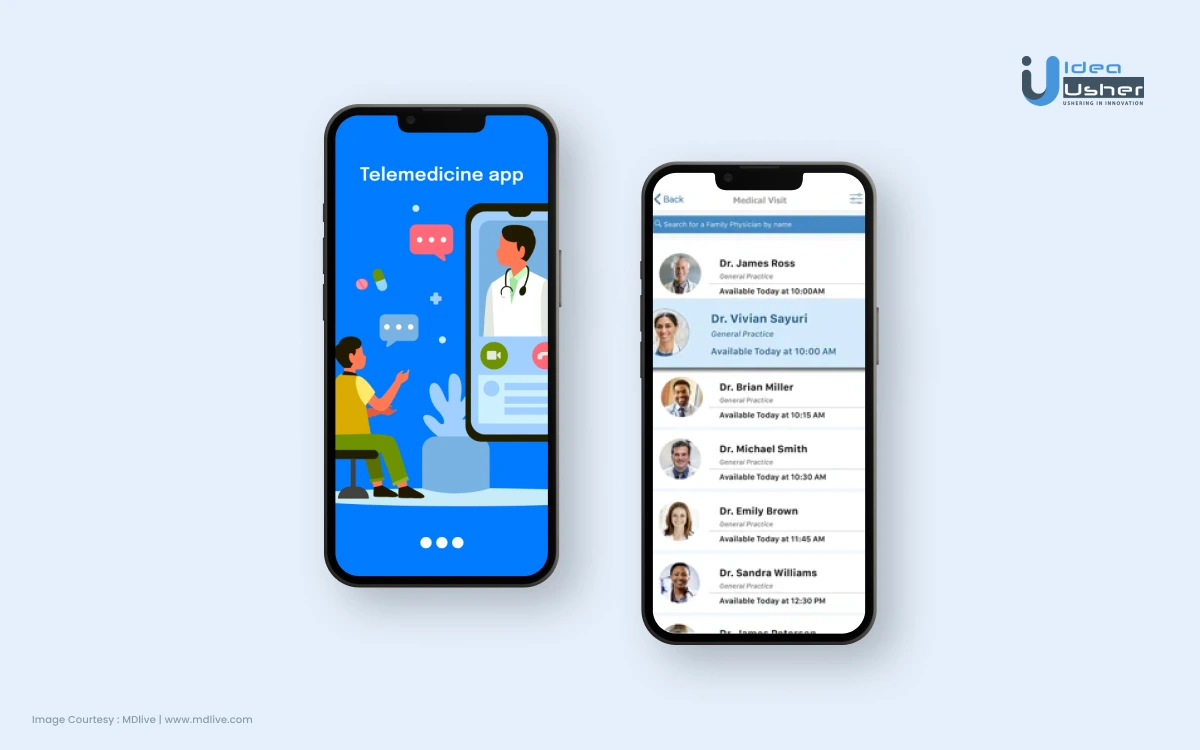
The telemedicine app development has increased with the onset of the deadly pandemic and limited personal visits. People no longer want to visit a doctor’s clinic to wait in long queues. Instead, sitting in the comfort of their home, they want to gain insights into the health problems and their related treatments.
Telehealth, the delivery of healthcare services through digital means, has emerged as a game-changer in the healthcare industry. With the global telehealth market expected to grow at a compound annual growth rate of 24.0% from 2023 to 2030, it is clear that telehealth is here to stay. The COVID-19 pandemic has accelerated the adoption of telehealth services, with more and more healthcare facilities shifting from traditional to virtual care methods. The rising penetration of the internet and innovation in smartphones is making it easier for patients to avail of telehealth services conveniently. In this blog post, we will explore the world of telemedicine app development and how it is changing the healthcare industry.
Developing a telemedicine application requires detailed attention, and all the obstacles get eliminated with proper guidance and qualifications. Let’s dive into the fundamentals of the online doctor’s app development process.
- How do telemedicine apps work?
- Why build a telemedicine app?
- What should you know before making a telemedicine app?
- Top 10 telemedicine apps in 2022
- Challenges to overcome while starting an online doctor app business
- Telemedicine App Features
- How to make a telemedicine app? Step-by-step guide
- Let’s wrap up the whole thing
- FAQ’s
How do telemedicine apps work?
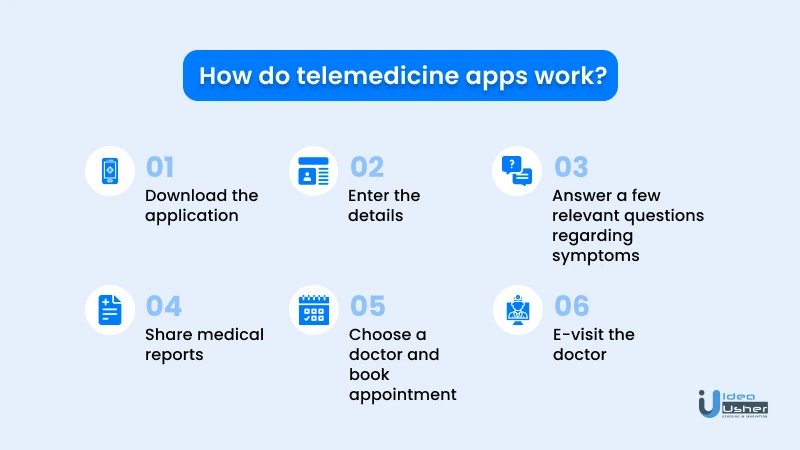
A telemedicine application enables patients to get an appropriate diagnosis without visiting the doctor personally. It is suitable for regular checkups, remote consultations, etc. Just like other applications, it covers the following steps:
- Download the application.
- Enter personal details, medical history, etc., and register.
- Answer a few questions about symptoms experienced currently.
- Upload any medical reports if available.
- Choose a suitable doctor you deem fit and book an appointment.
- E-visit the chosen doctor through live video conferencing and other available options.
- Discuss the medical details, history, current health conditions, and more.
- Get an e-prescription and treatment details.
Why build a telemedicine app?
The current times favor the telemedicine app development industry. It facilitates remote consultations for people unable to visit due to any reason. The quick and efficient services make it attractive to physicians, patients, and insurers alike. Establishing a telemedicine application in current times is necessary for the following reasons:
Benefits for the users
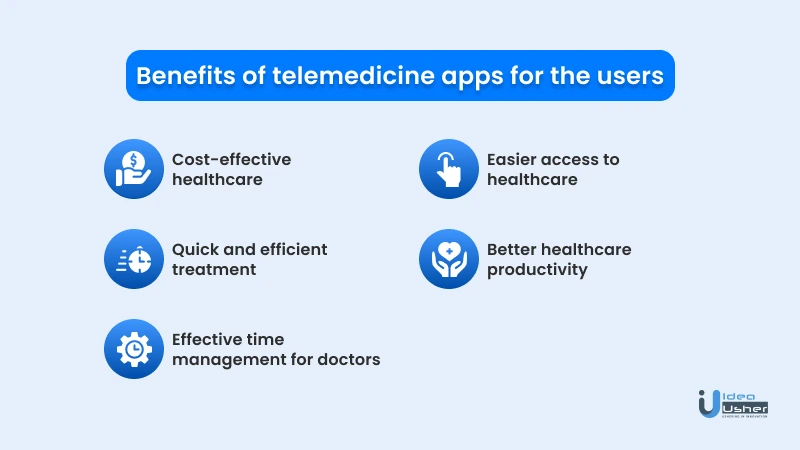
1. Cost-effective healthcare
Video consultations cut the cost of visiting doctors’ offices personally. There is no need for a hospital receptionist. The application takes care of appointments, medical history, etc. Thus, the storage, maintenance, and salary prices reduce, and the ultimate burden on the patient declines. Both patients and healthcare providers benefit from cost efficiency and effectiveness.
2. Quick and efficient treatment
Without leaving the comfort of their home, patients access personalized healthcare treatments from their chosen medical practitioners. There is no need to wait in line for appointments and meet doctors. Video conferencing apps facilitate efficient and expedited treatment. Since all the medical information is available on the app itself, there is no time wastage in looking for the same.
3. Effective time management for doctors
Doctors need not maintain excessive data and files for each patient. The relevant information is available on the app. Thus, there is no time wastage in looking for files, resulting in quick diagnosis. Moreover, the application allows networking with other medical professionals for their expertise in complicated situations and effective patient treatment.
4. Easier access to healthcare
Professional healthcare service providers are not available everywhere. It leads to people traveling distances for effective treatment. It can cause delays in emergencies.
Telemedicine app development overcomes the distance barrier making healthcare more accessible. Video consultations make it easier to detect, diagnose, and facilitate proper treatment of severely injured or unwell patients until they become stable.
5. Better healthcare productivity
With the constant growth in the healthcare industry with telemedicine applications, productivity has increased considerably. From studies, research, and development to training, educating medical students, and quickly treating patients, the healthcare industry has transformed.
Why are businesses interested in doctor-on-demand mobile apps?
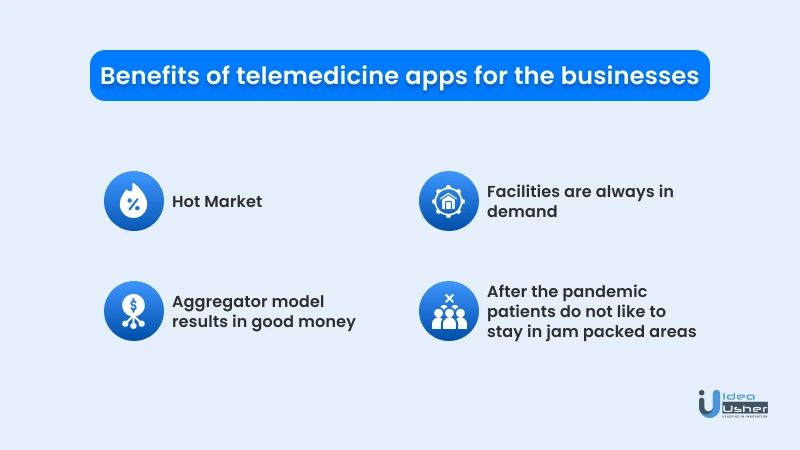
1. Hot Market
The telemedicine app development industry is booming currently. It offers businesses with a great potential to make profits. Many user needs haven’t gotten appropriately addressed, and accurately tapping into that market can result in massive success and growth.
2. Facilities are always in demand.
Telemedicine applications ensure the timely delivery of services to the user. The communication barriers between parties reduce because of streamlined and efficient app features. Every piece of information required exists on the app in files, forms, etc. Thus, businesses do not face any inconsistencies.
3. After the pandemic, patients do not like to stay in jam-packed areas.
The pandemic drifted humankind apart and forced them to stay distant to ensure good health. Thus, sitting in the doctor’s office, waiting for your turn, is no longer an option. Telemedicine applications hit this chord right and ensure patients get treatment for minor issues at home. Businesses can develop on this issue and monetize it through these apps.
4. The aggregator model results in good money.
Currently, businesses make good money from the aggregator business model. Telemedicine applications also work under this model, where the aggregator firm connects with healthcare service providers and promises them more customers. They create their brand and attract customers through targeted marketing strategies. Ultimately, the aggregator earns a commission.
What should you know before making a telemedicine app?
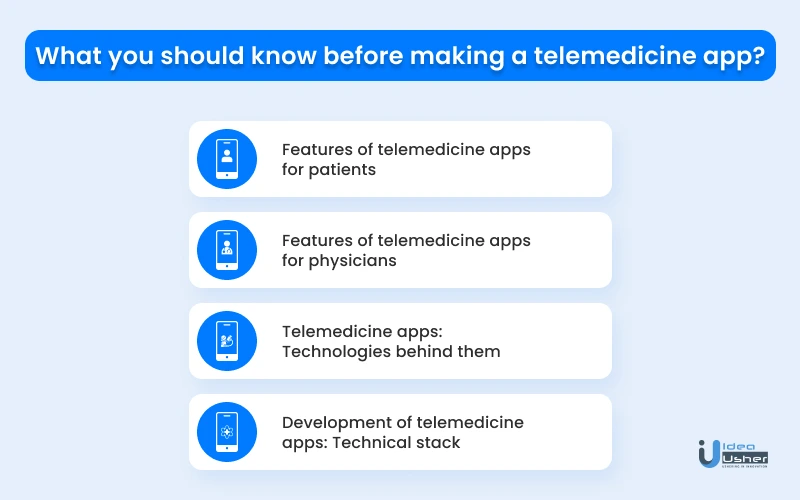
Timing, planning, and execution play a significant role in developing a telemedicine app. The following telemedicine app features and technical aspects need adequate consideration for success:
1. Functionalities of telemedicine apps for patients
The patient-related telemedicine application must cover the following features:
- A two-factor authenticated registration and access
- Concise patient profile and form-filling
- Search recommendations for doctors based on proximity, rating, specialization, etc
- Ability to book, cancel, or edit appointments and view preferred physicians’ timeslots
- Audio-video conferencing for real-time consultation
- Various payment methods and transaction history
- Personalized push notifications and reminders for appointments
- Advanced features like a customized dashboard, tracking medication, secure chats, in-app calls, navigation, insurance plans, etc.
2. Functionalities of telemedicine apps for physicians
A telemedicine app for doctors includes characteristics like
- Complete doctor profile with accurate details about their specialization, experience, license, etc
- Manage appointments, fix and approve time slots, etc
- Photo, audio, and video consultations
- Access patient profiles temporarily, history, hospital database, and other crucial information
- Other features like e-prescriptions, session recordings, dashboard analytics, pharmacy database, consultations, and referrals
3. Telemedicine apps: Technologies behind them
The telemedicine applications include the following technologies for streamlined services:
- Artificial Intelligence, language processing, chatbots, voice recognition, and machine learning enrich the users’ experience
- Since medical practitioners consume a lot of data, Big Data computations gather and evaluate electronic health records for improved treatments, accurate diagnosis, medical research, and fewer costs.
- Better patient cares with the contribution of the Internet of Things. It enables vitals tracking, diagnosis, medication adherence, a built-in emergency responding system, treatment suggestions, etc.
4. Development of telemedicine apps: Technical stack
Telemedicine app development requires a leading tech stack. Tech stack refers to a combination of frameworks, software, and programming languages assisting in application development. These applications are usually available on iOS or Android platforms or web apps built on React Native and Programming Nodes Language with Web RTC technology. A custom tech stack involves:
- WebRTC provides a simple application programming interface for a mobile app to work as a web browser.
- Electronic health records offer patients’ files electronically on demand.
- Interactive voice responses facilitate human and computer interaction.
- Cloud solutions provide access and exchange, management, and storage of information in the cloud anywhere, anytime.
- Integrations with HealthKits platforms facilitate data transfer between patients, doctors, and devices.
Programming languages
Applications work on different clients and server components with varying functionality. These require changes in programming languages, frameworks, and software for seamless functioning.
Thus, Swift technology is the best for developing iOS apps due to its robust simplicity, security, automatic memory management, interoperable functionality, and open source. Android app development with Java and Kotlin ensures improved performance, easy support, reliability, safety, convenience, and efficient networking.
Developing cross-platform apps is seamless with React Native, Xamarin, and Flutter.
Third-party integrations
A high-quality and enriching telemedicine app must be seamlessly integrated with vital tools and systems. These include video conferencing, Electronic Health Record systems, payment gateways, etc. They also involve documentation, insurance synchronization, patient portal integration, medical APIs, etc.
Integrations with these third-party systems must be clean, and compatible and not make the app vulnerable to attacks.
Innovative technologies
Machine learning, Artificial Intelligence, Blockchain, Chatbots, Voice assistants, Internet of Things are a few innovative technologies you can integrate into a doctor-on-demand mobile app. Real-time access, personalization, automated tedious healthcare processes, and seamless communication tools enhance the quality of telemedicine apps.
Top 10 telemedicine apps in 2022
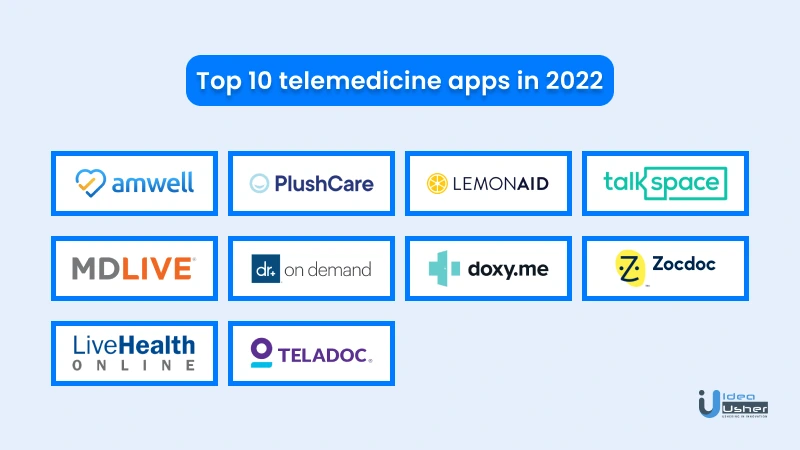
Have you ever wondered what it would be like to have shooting stomach pains at 2 a.m. with no doctor or hospital nearby? Telemedicine applications enable instant treatment through audio-video conferencing to ensure the symptoms don’t turn worse. With numerous apps available in the market, you must know the best telemedicine apps with a seamless user interface and value-adding features. The following are some of the top-rated telemedicine apps:
1. Amwell
Amwell has been the key driver in providing HIPAA-compliant (Health Insurance Portability and Accountability Act), secure, and one-stop telemedicine services. It offers 24*7 healthcare services for emergencies, therapies, psychiatry, and other known conditions at reasonable rates.
Patients can choose preferred doctors and access their conversations through the app.
Pros
- Good user interface
- High-quality streaming makes video interactions seamless. Quick, easy, and convenient platform
- Prescriptions can be sent to nearby pharmacies. Addresses various health concerns, including mental health
Cons
- Heavy battery usage
- Technical difficulties and glitches
- Limited doctors and health insurance plans
| Founder | Roy Schoenberg |
| Price | Free |
| Platform | Android and iOS |
| Downloads | 1M+ |
| Ratings | 4.4- Android, 4.9- iOS |
| USP | Urgent care to acute care |
2. MDLIVE
MDLIVE app enables users to get healthcare services, including psychiatrists, dermatologists, counselors, etc. It is a cost-effective solution, delivering seamless and secure consultations.
Pros
- It accepts insurance
- Choose your preferred physician or therapist.
- Schedule therapy for children aged ten or above
- MDLIVE website enables deaf or hard-hearing people to access the live chat feature, which is HIPAA- compliant
- Fix an appointment anytime around the year.
- Video or telephone therapies are available.
Cons
- Doctors are not readily available
- Limited availability of therapists
- The psychiatrists at MDLIVE cannot prescribe certain stimulant medications
- No recommendations for emotional support animals or complete disability paperwork
| Founder | Randy Parker |
| Price | Free |
| Platform | Android and iOS |
| Downloads | 500,000+ |
| Ratings | 4.6- Android, 4.7- iOS |
| USP | Certified doctors on call 24/7 |
3. Lemonaid: Same-day online care
Lemonaid provides quick and reliable healthcare assistance for addiction, cholesterol, acid reflux, sinus, and lab tests. The appointment gets scheduled at a fixed, reasonable cost per patient’s comfort.
Pros
- Professional support without leaving home
- Transparent communication of qualifications
- Mail-order pharmacy
- Easy-to-navigate app and website
- Excellent for treating a single condition
- Competitive Pricing
Cons
- Risk of improper diagnosis without in-person visits
- Physical visits are required for a complete checkup
- Cannot replace regular long-term medicare
| Founder | Paul Johnson |
| Price | Free |
| Platform | Android and iOS |
| Downloads | 100,000+ |
| Ratings | 4.2- Android, 4.9- iOS |
| USP | National online doctor’s office |
4. LiveHealth Online Mobile
LiveHealth makes available qualified and preferred doctors to address your needs. It includes lactation consultants, licensed therapists, registered dietitians, and more.
It keeps conversations private and secure. The app covers treatments for flu, bronchitis, allergies, skin infections, etc.
Pros
- Round-the-clock medicare access with a minimum of 10 minutes to connect to a physician
- Free to sign up on the application
- Psychotherapy and psychiatric care appointments are available
- Major insurance plans get accepted
- Good quality audio and video streaming
- Zero downtime and excellent technology
Cons
- Limited psychiatrist supply
- Poor customer service
- Healthcare professionals cannot prescribe specific medications
- It has not completed various essential medical forms like camp or school physicals, service dog requests, etc.
| Founder | American Well |
| Price | Free |
| Platform | Android and iOS |
| Downloads | 500,000+ |
| Ratings | 4.5- Android, 4.9- iOS |
| USP | Get in touch with a doctor from the comfort of your home |
5. PlushCare: Video Doctor visits
PlushCare connects you with qualified doctors for ongoing and non-emergency conditions. Apart from controlled substances, they can fill routine prescriptions like flu medicines, birth control, antibiotics, etc. The simple steps to follow and reach a physician/ therapist include choosing an appointment time and filling out insurance information.
Pros
- It offers a money-back guarantee
- The app supports many insurance plans
- It provides good customer care services
- A secure platform that also includes doctor notes and prescriptions to apply for leaves
Cons
- Costly than other available options
- Can cause delays in test results needed urgently
- There is no online chat support feature
| Founder | Ryan McQuaid |
| Price | Free |
| Platform | Android and iOS |
| Downloads | 100,000+ |
| Ratings | 4.8- Android, 4.9- iOS |
| USP | Affordable and convenient medical care |
6. Doctor on-demand
This unique application connects licensed and qualified professionals, physicians, psychiatrists, etc., to the patient. These doctors discuss the symptoms, medical history and perform examinations to recommend suitable treatment. They provide high-level customer-centric services.
Pros
- An insurance plan can cover costs
- Schedule appointments anytime on any day
- Choose your own therapist or physician by checking their qualifications and expertise.
- Professionals with numerous specializations
- Children’s mental health is also supported
- Get a full-care team- primary care doctor, therapist, a psychiatrist for a custom and complete plan.
Cons
- High costs without insurance
- Only a few days to get an appointment
- Limited therapist availability depending upon location.
- No treatment for severe mental health cases
- No prescriptions for stimulants or benzodiazepines
| Founder | Phil McGraw, Jay McGraw, Adam Jackson |
| Price | Free |
| Platform | Android and iOS |
| Downloads | 100,000+ |
| Ratings | 4.8- Android, 4.9- iOS |
| USP | Care is available anytime and anywhere |
7. Teladoc
Teladoc provides medical specialists for virtual talks. Irrespective of the medical issue or specialization needs, it lets you request a specialist and discuss your condition. Video or audio communication features are available.
Pros
- User-friendly interface
- Easy to navigate
- Fill out the medical details only once thoroughly
- Friendly healthcare providers
- Confidential doctor appointments and meets
- Willing and helpful customer service
Cons
- App crashes frequently
- Can get locked out and have difficulties in uploading photos sometimes
- High costs for non-insured people
- Hard time getting refunds
- Cannot prescribe specific medications
- Too long to make an appointment
| Founder | Michael Gorton |
| Price | Free |
| Platform | Android and iOS |
| Downloads | 100,000+ |
| Ratings | 4.3- Android, 4.8- iOS |
| USP | Only integrated virtual care system |
8. Doxy.me
Providing telemedicine services is not feasible for many healthcare providers. It puts hurdles in providing superior care to their patients. Doxy.me offers free and easy-to-use telemedicine services for healthcare providers so they do not get left out of the competition. It simplifies healthcare offerings to patients outside the clinical setting.
Pros
- Seamless and hassle-free experience to both patients and providers
- Easy exchange of documents and payment acceptance
- Unlimited, accessible, and fully functional plan
Cons
- Only accepts credit cards
- High charges for multi-provider plans
- Connectivity issues, occasional video freeze, and other technical glitches
| Founder | Brandon M. Welch |
| Price | Free |
| Platform | Available now on web browser only for mobile use (discontinued application) |
| Downloads | NA |
| Ratings | 4.5 |
| USP | Accessible from anywhere |
9. ZocDoc
This application aims at resolving issues faced by patients in booking online appointments. Instead of providing consultations online, it enables users to fix appointments for in-person visits with doctors.
Pros
- Easy online appointment scheduling
- Appointment reminders via texts, email, and calls
- Easy to fill out insurance inputs
- Convenient date and time slots
Cons
- Service costs expensive for healthcare providers
- Glitches can cause rescheduling appointments
| Founder | Cyrus Massoumi, Nick Ganju, Oliver Kharraz |
| Price | Free |
| Platform | Android and iOS |
| Downloads | 1M+ |
| Ratings | 4.2- Android, 4.6- iOS |
| USP | Find the right doctor |
10. Talkspace: Therapy and Counseling
The most convenient and effective way to improve mental health is by registering on the Talkspace app. It is an affordable subscription service that allows sending images, videos, text, audio, etc., to the therapist.
Pros
- Constant access to the therapist to share your thoughts anytime
- Flexible plans
- More comfort with text therapy
- No need to travel physically
- Psychiatry services available
Cons
- Not always practical
- No group counseling
- Only 30minute live sessions
- Age restrictions
- No sliding scale or financial aid
| Founder | Oren and Roni Frank |
| Price | Free |
| Platform | Android and iOS |
| Downloads | 500,000+ |
| Ratings | 4 – Android, 4.7- iOS |
| USP | Licensed therapist |
Challenges to overcome while starting an online doctor app business
Although developing a telemedicine application sounds great in current times, you still need to be wary of the pitfalls in the development process. The app development process is not as rosy as it sounds. Ensuring a successful launch, an attractive UI/UX design, fully functional features, and more requires attention to the intricate details. The following points highlight the things to put extra focus on in online doctor app development:
For businesses
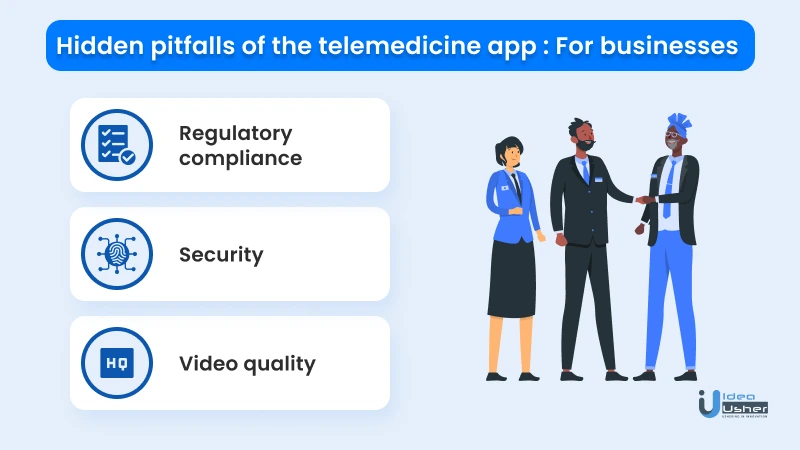
1. Regulatory compliance
Telemedicine applications deal with sensitive patients’ data. Therefore, privacy, security, and related requirements are at their peak. Healthcare authorities put various regulations for app developers to adhere to throughout the app’s life.
Mobile applications should comply with the Health Insurance Portability and Accountability Act (HIPAA) in the USA. A reflection of what the rules look like is as follows:
- The app must have a synchronized monitoring process, data storage, and login control.
- Unauthorized access and breaches are frowned upon, and applicable penalties will get charged.
- The tools used must ensure a secure data transfer process and all the norms implemented successfully.
Thus, these regulations aim to enhance data security, accessibility, reliable storage, proactive approach towards cybercrimes, safe exchanges, etc. The legal and privacy regulations depend on different territories. Developers must ensure compliance throughout the development and app life to make it a highly credible platform for users.
2. Security
While putting in personal medical, payment, and other details about themselves in an application, a user puts their trust in the app. They would want nothing wrong to happen to their sensitive information. They would like clear accountability and a seamless refund process if something happens.
These requirements push app developers to prioritize data security and employ trusted tools, proven frameworks, libraries, etc., for protection against illegal data exploitation and authentication breaches. Technologies like cloud servers play a significant role in storing and securing information.
A robust backend infrastructure ensures cybercrime prevention. A lack of experience and expertise in implementing security algorithms for building compliant and secure applications can be costly to developers.
Leveraging tools with the latest security updates and a regular self-assessment system is crucial in saving time and preventing the app from any vulnerabilities.
3. Video quality
Telemedicine applications thrive on live video conferencing, audio, and chats for effective diagnosis and prescription by doctors. However, if the streaming quality is poor, it will negatively affect the entire process.
A robust video calling system is a must-have attribute in a telemedicine app. It determines the relationship between a doctor and a patient. It will help prevent ineffective treatment half-cut calls and provide instant relief to someone suffering from some disease.
Although camera quality matters in video streaming, it is still not the only thing that matters. Bandwidth issues and invalid code can also result in poor video quality. Therefore, developers need to employ robust models for a solid streaming platform.
For users
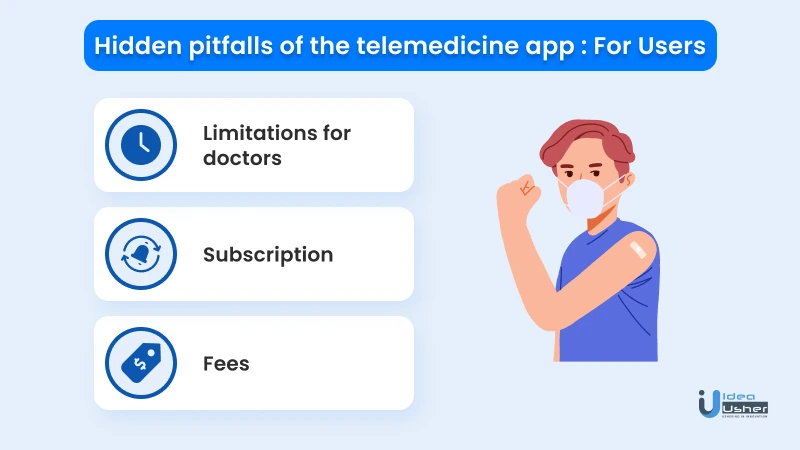
1. Limitations for doctors
Although telemedicine applications highlight a beaming future for the healthcare industry, it is not a foolproof plan against severe health problems. Telemedicine applications can prevent, diagnose, and treat minor issues only. It cannot replace in-person visits for emergencies, shooting pains, heart attacks, and other casualties.
Therefore, in terms of increasing productivity, it may do the opposite. Often, correct diagnosis is not possible online, with limited features for an overall checkup. If a doctor prescribes a medicine that may or may not work based on the visible symptoms online, they may get negative reviews, which would impact their reputation.
Therefore, telemedicine applications may not be an excellent friend of doctors and may cause problems in their treatments. However, doctors can maintain a cordial relationship with existing patients and conduct regular checkups and health monitoring via telemedicine apps.
2. Subscription
Many telemedicine applications generate revenue through a subscription-based model. Although there is nothing wrong with it, it may still not be very encouraging to users. Often people visit doctors when they feel sick, have a regular checkup, and more.
While telemedicine apps provide the convenience of getting diagnosed at home, paying a periodic subscription does not make sense. Unlike Netflix, Spotify, and other applications that a user uses daily, telemedicine applications are more helpful when the user feels sick.
Therefore, paying for a periodic subscription for using the app a few times is not feasible. Telemedicine applications using this model must offer more advantages and enriching features that are worth users’ money.
3. Fees
Under a fee-based revenue model, the app charges money whenever a transaction occurs between a patient and a doctor. It is the most profitable earning method in telemedicine application development.
However, it also makes these platforms expensive for both parties. The ultimate burden of paying the fees comes on the users’ shoulders as the doctor will include it in his costs. Moreover, these applications charge medical practitioners to avail the apps’ services. These expenses add up to the increase in healthcare providers’ costs.
A telemedicine application development company should strive to balance costs and revenue for themselves and related parties and ensure competitive pricing.
Telemedicine App Features
1. Easy Patient Registration
Patient registration is a critical aspect of telemedicine, and it’s essential to make the process simple and trustworthy for patients. To achieve this, your app should only request the bare minimum of information needed to register the patient, and the authentication method should be robust and secure.
Patients appreciate an easy-to-use registration process that allows them to upload pictures of their medical documents, insurance verification data, and previous medications instead of typing everything out manually. This can save time and ensure accuracy, enhancing the patient experience.
The app should also enable patients to choose the doctor they need and schedule an appointment quickly and easily. The process should be user-friendly, with clear instructions and guidance provided at each step to ensure a smooth registration experience.
2. Patient Dashboard or Profile
The patient’s dashboard is an essential component of a telemedicine app that aids doctors in developing a quick and effective treatment plan for their patients. It provides an overview of the patient’s personal and medical information, which helps the doctor make an accurate diagnosis.
This feature focuses on both the general and specific aspects of the patient’s condition and categorizes patients according to their medical needs.
Some of the key elements of the dashboard include:
- Current information on the patient’s health status
- Details of the assigned room and ongoing medication
- The patient’s primary complaints
- Insurance information
- Previous medical visits
- Patient management
- Highlights of remote patient monitoring systems
3. Geolocation
One of the key advantages of telemedicine is that it eliminates the need for patients to travel to physical healthcare facilities. To enhance this experience for the users, it is essential to include geolocation features in the app.
This enables the app to access the user’s location and provide directions to the nearest hospitals and pharmacies, as well as estimate the time it takes to get there. By doing so, patients can quickly identify the closest and most convenient healthcare facilities to receive medical attention.
4. Appointment Management
By enabling calendar integration, patients can receive phone-based reminders for all their upcoming medical appointments, which helps ensure that they don’t miss any appointments.
For doctors, having the ability to schedule appointments and keep track of their progress is crucial to providing effective care. They can view patient profiles and appointment requests, and easily manage their schedules using this app integration feature.
The app’s patient queue is displayed, and doctors can filter patient profiles to quickly find the information they need. This integration feature also enables doctors to reschedule appointments when necessary, ensuring that patients receive the care they need at the right time.
5. Communication Method
According to a McKinsey & Company survey, around 30% of respondents expressed interest in telehealth services that include online/video counseling and in-app chat with a doctor.
The focus during telehealth app development must be on the integration of:
- In-app chat option;
- In-app calling;
- Live video sessions.
Benefits of telemedicine include the ability to ask questions about symptoms during teleconference appointments, using pictures and video consultations as a substitute for in-person evaluations, and leveraging cloud technology and app integrations to enable real-time communication and remote patient diagnostics.
6. Electronic Health Record
Integrating electronic health records (EHR) into telemedicine applications enhances their effectiveness.
EHR stores all vital health information such as blood work, lab results, radiographic images, medications, and treatment history. On the other hand, EMR records the patient’s treatment history.
The integration of EHR with the telemedicine app allows for seamless patient record processing and centralization, leading to time-saving for both patients and doctors. Furthermore, the integration prevents data duplication from virtual visits.
The ability to monitor the patient’s health progress and conduct necessary inspections is facilitated through the app’s integration with EHR. As a result, doctors can make informed decisions about their patients’ health without delay.
7. Remote Patient Monitoring
Certain telemedicine apps have been specifically designed to assist patients with self-monitoring conditions. These platforms leverage Remote Patient Monitoring (RPM) technology to help patients and healthcare providers keep track of pregnancy records and provide guidance on maternity programs or manage chronic conditions that require ongoing monitoring, such as cholesterol or glucose levels.
In addition, some developers are focusing on developing RPM-based apps that help patients combat severe illnesses like cancer and improve their overall quality of life. Such applications offer patients the convenience of receiving healthcare services from the comfort of their own homes while also allowing healthcare providers to monitor patient health and respond appropriately.
8. E-Prescription
Electronic prescribing (e-prescribing) is an essential aspect of healthcare delivery that benefits patients, pharmacies, and prescribing physicians. This technology allows doctors to send prescriptions to pharmacies electronically, eliminating the need for paper prescriptions.
E-prescribing enables doctors to have access to the patient’s insurance form records and provides comprehensive drug lists along with dose information. This reduces the likelihood of errors in the prescription and pharmacy process, increasing patient safety and streamlining workflow.
The renewal process for prescriptions is faster and more straightforward with e-prescribing, and integrated pharmacy operations can serve the same drugstores. Additionally, it helps doctors understand the patient’s history, reducing the likelihood of hospital readmissions.
Patients can also benefit from e-prescribing, as it reduces the cost of drugs and provides a tracker for medications. This technology is an essential part of modern healthcare delivery, and it helps to ensure that patients receive the care they need in a safe and efficient manner.
9. Payment Options
Different telemedicine apps offer different payment options, but one popular app, Doctor on Demand, offers multiple ways to pay for their services. Patients can use a credit card to pay for a telemedicine consultation, or they can use insurance plans such as Medicare or Medicaid.
Some employers also offer telemedicine coverage to their employees as a part of their health benefits package. Additionally, some apps may offer coupons or discounts for their services. It is important to note that payment options may vary depending on the telemedicine app and the patient’s location.
10. Feedback
When it comes to telemedicine, patient feedback is crucial for improving the quality of care provided by doctors and helping them advance in their careers. Therefore, it is essential for any telemedicine app to allow patients to rate and review their doctors. This feedback can also help new patients find the right physician who can address their specific needs.
To ensure the integrity of the feedback system, it’s important to design the app’s scaling features so that only patients who receive treatment can rate their physicians. This will help ensure that the feedback is accurate and truly reflects the patient’s experience with the doctor. Overall, allowing patients to rate and review their doctors is an important feature that can benefit both patients and healthcare providers.
How to make a telemedicine app? Step-by-step guide

Once clear with the requirements, pitfalls, and everything to know about telemedicine apps, it is time to dive into the step-by-step creation process. Developing a telemedicine application requires following the steps mentioned below for assured success:
Step 1. Research, plan, and strategize
Market research
Before developing a telemedicine app, it is essential to conduct thorough market research. Since these applications are available in abundance in the market, in-depth comparisons and analysis will provide the shortcomings in existing applications and clarify the actual needs of the users. Addressing the pain points of existing applications and fulfilling user requirements will lend the application a positive word of mouth even before launching.
Mark the target audience
Market assessments are crucial to providing developers with a unique selling proposition. It enables them to mark the target audience. The application must increase the business of medical practitioners.
Strategy for profitability
Developers must create a profitable and futuristic monetization strategy depending on market trends. Understanding the market and the competition will help develop strategies to disrupt and build a strong position.
Deciding the features
Comprehending customer needs and available solutions will enable outlining the must-have and unique features to add to the application. Moreover, planning the platforms to launch the app, countries, security rules, etc., comes under the planning phase.
Step 2. Choose the technology
Connect with doctors and physicians
After covering the market of telemedicine applications and determining features, competitive stance, strategies, etc., it is time to involve the tech team and consider the technical development of the app. However, consider connecting with the healthcare service providers and doctors before as they play a crucial role in your success. Considering their opinions while developing the app will help streamline services and ensure a seamless experience.
Consult a professional tech team
Begin choosing the best platform to launch the app on- Android, iOS, or both. Android, iOS platforms have guidelines and regulations to keep in mind while developing the application. Gather a professional technical team of developers, quality analysts, and project and quality management service providers for such considerations.
Consider technology
Integrate different technologies and third-party features like Artificial Intelligence, chatbots, Blockchain, the internet of things, etc., for a better user experience. The professional team will have the required knowledge and expertise to uplift the development process. They will help select suitable cloud infrastructure.
Development tools and technology
Use appropriate programming languages like Java, Kotlin for Android, and Swift for iOS. Deploy necessary tools for elastic searches, filters, emails, geolocations, notifications, etc. The backend development requires integrating features like videoconferencing, chat, database, APIs, and framework.
Step 3. UI/UX design and front-end development
Once everything is clear, and you have gathered a team of highly qualified professionals, it is time to put the plan into action and create an efficient and beautiful application. A telemedicine application must satisfy users’ needs and, thus, should not get overloaded with unnecessary features for attraction. It should be easy to navigate and use.
The app should solve the ultimate purpose for both doctors and patients and should not be confusing to utilize. Designing the app begins with deciding on a suitable wireframe, app layout, interface, navigation, etc., per the user’s requirements.
The app should be responsive and usable on different devices. Confirm its orientation and place animations where they look smooth. The call-to-action buttons must work perfectly. The color schemes must be attractive and engaging to the target audience.
Step 4. Ensure security and compliance
While developing the telemedicine app, ensure the employment of appropriate security tools. It should comply with the HIPAA rules, medical standards, industry-wide standards, data security, protection rights, etc.
Appropriate measures to prevent security breaches and cybercrimes must be in place. Developers must add two-factor authentication for access by authorized individuals only. They should correctly set the admin privileges to avoid misuse or misappropriation.
The payment system and gateways must be reliable for users to enter their details. They should have no worries about secure payments while paying.
Step 5. App testing and performance
After creating the application, test its performance in different circumstances. Ensure that it works perfectly with other devices and operating systems. The app should be compatible with various updates and versions and should have the ability to handle multiple users simultaneously without crashing.
Conduct beta-testing, which involves collecting feedback from non-technical users about the performance and experience of the app. It will help developers make the necessary changes before launching the app.
There are various testing methods, including API testing (Application Programming Interface), Quality Controls, Vulnerability Assessments, and Unit testing. Performing app updates will indicate whether the app is working or not.
These performance tests must continue even after the app gets launched to ensure a hassle-free user experience.
Step 6. Launch and maintain
Once confident with the app design, layout, compliance, performance, and compatibility tests, it is ready to launch. Following the app store guidelines, give a unique name to the application, and add clear screenshots for users’ reference. The app description should highlight the problem solved and exciting features offered to attract the potential user to download.
With the help of explanation videos and tutorials, assist the user in using the application. It should support multiple languages. The maintenance and updating process is ongoing and a must. Fulfill App Store Optimization norms and SEO for better search results.
Continue fixing bugs and glitches for a positive user experience and to disrupt the existing market. Update the app if the platform or user needs demands.
Let’s wrap up the whole thing
Telemedicine applications serve an essential purpose in doctors’ and patients’ lives. It adds convenience and ensures immediate medical treatment for relief in severe cases. In current times, properly developing an app that addresses users’ grievances and needs will assure success.
The abundant telemedicine application options available in the market provide immediate consultation and payment to patients and doctors. The attractive user interface, elements, features, and compliance with security measures are must-have attributes for a telemedicine app.
The development process may seem lengthy, but a proficient team of developers like Idea Usher can guarantee excellent results. The significance of working with a qualified team is paramount and a prior consideration in telemedicine app development. You can reach out to this team of experts at
E-mail: [email protected]
Phone Numbers : (+91)9463407140, (+91)8591407140, and (+1)7329624560
FAQ’s
Q. Who benefits from a telemedicine app?
The telemedicine application benefits patients and medical providers with 24*7 access to healthcare, reduced costs, less shortage of medical workers, time efficiency, streamlined data management, security, storage, etc.
Q. Which features are a must-add for a seamless user experience?
Although there are many, the following are critical for a telemedicine app:
- Profile management
- Live video conferencing
- Appointment scheduling and availability through the calendar
- Notifications and reminders
Q. How to monetize telemedicine apps?
You can adopt the following monetization strategies and models:
- Periodic subscription plans
- Fees from the transaction between patients and doctors
- In-app purchases
- Ad-based
- Combination of a few
Q. What mistakes should be taken care of while developing a telemedicine app?
While creating the app, validate the idea. Choosing the right or wrong professionals will make a considerable difference. Neglecting the intuitive design, compliance requirements, and design can cause trouble.








Sakshi Gautam